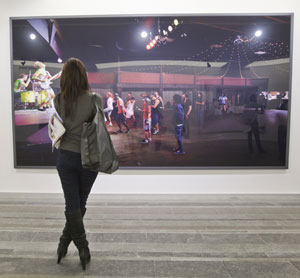The art of cold surfaces
Kyiv’s PinchukArtCentre hosts three exhibits of entirely different and, at the same time, similar artists
All the three expositions are premieres: “Photography: in Light, Black, Color, White, and Dark” by the Canadian Jeff Wall and “Beauty” by Britain’s Gary Hume are the first solo exhibitions of these artists in Eastern Europe, while the installation “Neofolk” by the Ukrainian Mykola Matsenko has been built specially for the PAC-UA hall intended for supporting national art.
Hume’s “Beauty” consists of about 60 pictures and sculptures. He began his artistic career with semiabstract and semi-designer paintings on hospital doors in the 1980s. Then the artist got down to studying the human body and painting portraits, nature, birds, and flowers.
Hume is an example of urban visual techniques, mostly advertising and design, transforming such a seemingly reclusive thing as painting. Almost all the works, except for a few sculptures, which look like road signs or advert boards, were made with enamel paints on aluminum sheets. The results resemble pop art that ingratiates itself with the ordinary spectator, on the one hand, and rationally simplified abstractionism, on the other. The bright, even garish, local colors, glossy surfaces, and compositions also resemble, if we take into account certain banalities, the works and stylistics of the artist’s famous predecessors. One work shows the influence of Marcel Duchamp, another that of Kazimir Malevich, and the shadows of Joan Miro, Pieter Mondrian, and other experimenters are hovering somewhere else. You can almost immediately feel the secondariness and superficiality of this office decorativism of sorts. At the same time, “Beauty” can be hardly called a failure: it is clear that Hume is a gifted painter who knows how to instill refined plasticity in an image and outline the latter with just one or two lines, as he does in a large picture, Big Bird, or in the stone Bird-Shaped Sculpture. Unfortunately, these are perhaps exceptions.
The Ivano-Frankivsk-born Mykola Matsenko is trying to present the Ukrainian tradition by means of abstraction. He has created 46 square-shaped works for “Neofolk,” which follow, in a way, folk embroidery. The author noted: “This is the only project in my lifetime, where the line runs from the heart, not from the head. It is a reflection of a carpet from my childhood. On the one hand, I made it a color study exercise, and, on the other, it is a very spiritual, emotional, and the only irrational work in my creative life.”
Indeed, even if there are some emotions here, they are of a not-so-cheerful nature. Matsenko decorated the walls of two halls with white tiles and he added, in the larger room, an intermittent frieze to the abovementioned multicolored square-shaped little pictures with the central element shaped as a cross. The white tiles remind one of not much a newly-built public toilet as of a surgery ward or even a mortuary whose space is suddenly torn apart by this bright dotted line – in a word, this calls up mixed associations. It is not known whether the artist mulled over this effect, but, on the whole, this reflects quite clearly the current state of national culture.
Undoubtedly, “Photography: in Light, Black, Color, White, and Dark” is the central event that includes Jeff Wall’s 17 broadside photographs and 7 back-lit pictures.
Jeff Wall was born in Vancouver, Canada, in 1946. His signature works are large photographic transparencies mounted on light boxes. He has had a lot of international solo exhibits at such prestigious institutions as ICA, London (1984), the Irish Museum of Modern Art, Dublin (1993), the White Chapel gallery, London (2001), the Museum of Arts, Wolfsburg (2001), the Hasselblad center, Goeteborg (2002), Astrup Fearnley Museum, Oslo (2004), and retrospectives at the Schaulager gallery, Basel (2005), the famous Tate Modern gallery, London (2005), the Guggenheim gallery, Berlin (2007), and the Museum of Modern Art in New York (2007).
He does not have reportage photographs as such. What can provide an impetus for creating one picture or another may be a fleeting street-corner impression, a childhood memory, or even a classic canvas (particularly, Las Meninas by Velasquez or A Bar at the Folies-Bergere by Edouard Manet). Wall works as if he were a stage director: he selects performers, lighting, location, and the props. Flawless mastery of the genre, meticulous preparation, and a precise vision allow him to do incredible things: if necessary, he achieves a complete effect of the abovementioned suddenness. His photos are, at first glance, standard everyday-life scenes, landscapes, or portraits, but a closer look will bring out an exquisite and well-thought-out composition, in which every picture is harmonious in the tiniest details. This may be a variation of Manet’s postimpressionist canvas, a black-and-white social photo, a landscape, the semiabstract large plan of a boarded-up window – and all these images of entirely different genres will always be of an exceptional esthetic quality.
Although the artists are obviously different, the three exhibits are the same in terms of concept: it is an absolute triumph of the form and perfectly embodied (in the case of Wall), albeit distanced, rationalism. In a way, all the three projects make one meta-exhibit. As a result, we can see what may be called a manifesto of the pure form, an art of cold surfaces in the dead of winter.
Read an interview with Jeff Wall in one of the next issues of The Day.






